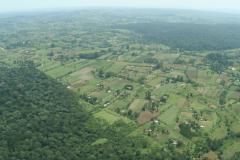Course module: Soil carbon benefits
| Course title: | Benefits of Soil Carbon |
| Course code: | ISRIC-SOC |
| Subject areas (Curriculum): | Soil use and management; environmental services |
| Duration: | 2 hrs |
|
Short description: |
Human-induced increase in atmospheric greenhouse gas (GHG) concentrations poses a threat to the global environment and human well-being. Mitigating GHG emissions is a major challenge and needed to curtail climatic change. Some two thirds of all terrestrial organic carbon is contained in the soil; vegetation accounts for the rest. Soils are important long-term reservoirs of organic carbon; inorganic (carbonate) carbon can be important in semi-arid and arid regions. The amount of carbon in soil, present in soil organic matter (SOM), is strongly influenced by changes in land use and management. Sustainable land management (SLM) projects have the potential to not only reduce GHG emissions, by reducing emissions from biomass burning, biomass decomposition and the breakdown of soil organic matter (SOM), but also to sequester carbon (C) through practices that increase biomass production and promote the build-up of SOM. This introductory lecture provides an overview of important development and research issues for monitoring, reporting and verifying (MRV) soil carbon benefits in SLM and GHG mitigation projects followed by an overview of the online tools developed for the GEF by the Carbon Benefits Project (CBP). It includes a hands-on exercise with the Simple Assessment Tool developed by the CBP for a hypothetical test-area in Kenya. [Note: This module was part of the GSOCmap workshop organised by ISRIC for GSP/FAO (6-23 June 2017, Wageningen). The course itself is no longer given, please see freely available training materials] . |
| Moderators: | Niels H. Batjes |
| Target audience: | BSc and MSc level students in agriculture and other environmental sciences |
| Requirements: | Basic knowledge of geography, soils and plant production; good understanding of English. |
| Programme: |
|
| Objective: | After completion of this introductory course, participants should have a broad understanding of: 1) main factors regulating the global distribution of SOM, 2) options for enhancing SOM levels with improved management, 3) an insight in (new) approaches and techniques for measuring, monitoring and modelling SOC, 4) recognize the multiple benefits of soil organic carbon as held in SOM, 5) be familiar with the CBP modelling system, and 6) have some hands-on-experience with at least the Simple Assessment Tool. |
| Software / materials: |
A room with PC's will be available for the hands-on excercise with the CBP tool. |
| Case studies: |
The case study considers an hypothetical project area in Kakamega, Kenya for which the necessary data are provided. Subsequently, time allowing, participants may explore project scenarios for an area of their choice. For this they must supply information about intial land use, the baseline scenario and project scenario for an area demarcated using the on-line digitizing tool of the Simple Assessment tool.
|
| Literature/Reader: |
1) Batjes NH 2013. Reader for the Soil Carbon Benefits module (World Soils and their Assessment), ISRIC Spring School (22-26 April 2013). ISRIC - World Soil Information, p. 17 (PDF) 2) Batjes, NH 2017: Benefits of soil carbon (Lecture notes and exercise with CBP tool), Course materials for FAO/GSP GSOC2017 map training, ISRIC (6-23 July 2016, Wageningen) (Download page) 3) Ravindranath NH and Ostwald M 2008. Carbon inventory methods - Handbook for greenhouse gas inventory, carbon mitigation and roundwood production projects. Advances in Global Change Research, Volume 29. Springer, Heidelberg, 304 p (PDF) 4) IPCC 2006. IPCC Guidelines for National Greenhouse Gas Inventories Volume 4: Agriculture, Forestry and other Land Use. IPCC National Greenhouse Gas Inventories Programme, Hayama (JP) (PDF) |
| Minimum number of participants: | 10 |
| Maximum number of participants: | 20 |
